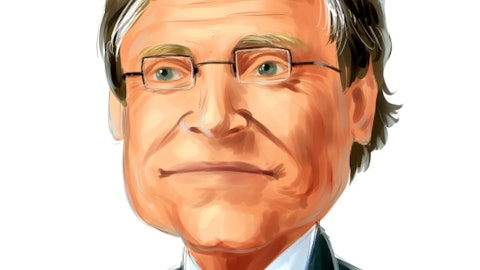Ron Josey : Thanks for taking the question, guys. Always good to hear from you. I wanted to ask too, please, Mark, in the presentation of the investor letter, the per unit insights were super helpful. As we think about, staying in Step 2 or when do we move to Step 3. I want to ask just about specifically I think we saw inbound transport costs declined $900 over the last 12 months on a per unit basis. So we’d love to hear what drove those gains and how far away do you think we are to getting to that, like peak efficiency, maybe not just with just inbound transport costs, but just overall. I assume there’s more ways to go. But we’d love your thoughts there. And then, Ernie, as we think about, preparing ourselves for whenever the next step is, same day delivery is something that’s super interesting.
We’d love to hear just early results for now and I think two or three states and cities. We’d love to hear any insights on how that might be driving greater conversion rates and really just how the network is positioned to support same day delivery. Thank you.
Mark Jenkins: Sure. Ron, well, let me start with your first question. So I think what you’re referring to is, in the last 12 months we have reduced our reconditioning plus inbound transport costs by about $900. I think that’s a very significant win and one of the progress points that we’re very excited about when we’re thinking about the progress that we’re making in Step 2. I think what were some of the drivers of that? So I think if we start focusing on reconditioning, in-sourcing was probably the single biggest driver. So basically taking services that had previously been provided by third parties in the inspection and reconditioning centers and taking them in-house and doing them ourselves, and that obviously saves costs and allows to have better control of the process.
So I think that’s been a big win. In addition, I think we’ve gotten better at standardizing processes, making sure we’re properly normalized at our staffing levels. We’ve made some big gains in proprietary inspection and reconditioning center software, including fully in-sourcing our inventory management system. I think that’s a big win and a big improvement that allows us much better control of the process and allows us to really have, again, clear standards and processes that are executed on every single car that’s rolling through the facilities. We’ve also made gains automating parts procurement. It used to be a highly manual process and a highly more variable process than it is today. So I think we’ve made big wins there in the proprietary software development department.
So those are a few of the places where we’ve made real gains in reconditioning. I would note that we do see opportunities for further gains in those areas that I just pointed to in recon. We don’t think we’re done. We do see opportunities for further gains in reconditioning costs per unit. Moving to inbound transport, I think a couple of the sources of gains there are, getting better at logistics network utilization, as well as having lower inbound miles. And so both of those things I think have also led to declines in inbound transport costs. Now, one thing I did want to call out is there’s actually two $900 improvements that are of note. I just talked about, and I think your question was focused on the $900 gains in retail cost of sales. However, we also have an additional $900 of significant gains in our operational selling general and administrative expenses.
And that’s, we’ve broken out some detail on that in our shareholder letter as well as the accompanying materials. And so in total, that’s $1,800 of total gains in those more variable cost components. If I just say a few words about the gains. That second $900 of cost gains, I think, that has also been very broad based. So that would include cost improvements, for example, in our customer care centers. It would include cost improvements in our market operations, which is our last mile delivery network. It would include cost gains in our logistics and transportation departments, which house the logistics network that moves cars around for us. And we’ve made very significant gains in some of those operational areas as well. Those have been driven by process automation, improved staffing and scheduling, better proprietary logistics route management, and activity pairing software.
We’ve made some real improvements, both in terms of processes and technology, that have driven that second $900 of unit economics improvement, and that one being since Q4 2022. So I think obviously we’re very excited about all that. $1,800 in reductions on a per unit basis in the more variable components of the cost structure, I think is something we feel really great about and is part of the reason that we’re so excited about what we’re doing here in Step 2, before we transition to take advantage of our excess capacity and return to profitable growth.
Ernie Garcia: Yeah, and I’m going to jump on that for a second as well before heading to same-day delivery. What I would also say is, those gains are very high-quality gains. Those aren’t cutting corner gains. During this period we’ve seen warranty claims, for example, go down. So we’ve seen frequency of warranty claims go down, while we’ve been driving down reconditioning expenses. A lot of the cost savings that Mark is talking about are actually making the customer experience better. The scheduling benefits in logistics means that we’re delivering cars faster, we have fewer pushes. When customers are calling advocates, calls per sale are down approximately a third year-over-year. We’ve seen calls per advocate – sorry, sales per advocate have doubled year-over-year.





